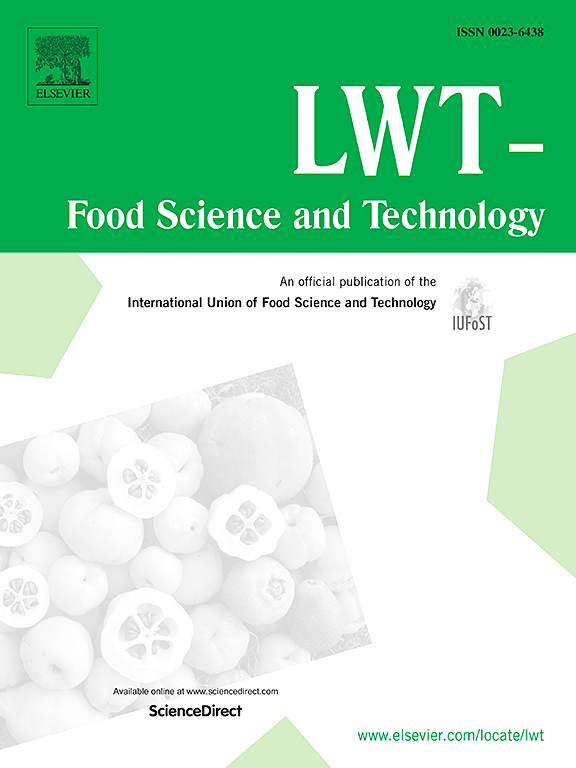Evaluation of carrot and agroindustrial residues for obtaining Tenebrio molitor (yellow mealworm) powder enriched in bioaccessible provitamin A and colourless carotenoids
IF 6.6
1区 农林科学
Q1 FOOD SCIENCE & TECHNOLOGY
引用次数: 0
Abstract
In this pilot study Tenebrio molitor larvae were fed with two residues (olive leaf meal and spent Pleurotus ostreatus substrate meal) and wheat flour (control). Carrot was used to provide a source of water and carotenoids. The objectives were to compare the effect of residues on growth and proximate composition of the flours and their carotenoid profile, by providing carotenoids and/or affecting their absorption by larvae. Additionally, the carotenoid bioaccessible content in Tenebrio molitor powder was evaluated. The powder obtained from larvae fed with the residues had a similar proximal composition to the control and residue meals tested did not affect negatively larval survival nor growth. Larvae accumulated significant amounts of carotenoids, especially when fed with olive leaf meal, followed by spent Pleurotus ostreatus substrate meal, even though the latter lacked detectable amounts of carotenoids. This suggests that the composition of the fungal substrate may favour a higher carotenoid uptake mechanism in mealworms compared to control. The colourless carotenoids phytoene and phytofluene exhibited the highest carotenoid bioaccessible content, followed by the provitamin A carotenoids β-carotene and α-carotene. Summarizing, T. molitor fed on agri-food residues can accumulate bioavailable and health-promoting carotenoids, that can contribute to alleviating global problems such as vitamin A deficiency.
胡萝卜和农业工业残留物的评价,以获得富含生物可及的维生素原A和无色类胡萝卜素的黄粉虫粉
本试验采用两种残渣(橄榄叶粕和废平菇底粕)和小麦粉作为对照。胡萝卜被用来提供水和类胡萝卜素的来源。目的是通过提供类胡萝卜素和/或影响幼虫对类胡萝卜素的吸收,比较残留物对面粉生长和近似组成及其类胡萝卜素的影响。此外,还对黄粉中类胡萝卜素的生物可及性进行了评价。用这些残留物喂养的幼虫获得的粉与对照组具有相似的近端组成,并且测试的残留物饲料对幼虫的存活和生长没有负面影响。幼虫积累了大量的类胡萝卜素,特别是当用橄榄叶粉喂养时,其次是用过的平菇底物粉,尽管后者缺乏可检测到的类胡萝卜素。这表明与对照相比,真菌底物的组成可能有利于粉虫更高的类胡萝卜素摄取机制。类胡萝卜素生物可及性含量最高的是无色类胡萝卜素、植物烯和植物荧光素,其次是维生素A原类胡萝卜素β-胡萝卜素和α-胡萝卜素。综上所述,以农业食品残留物为食的T. molitor可以积累生物可利用的、促进健康的类胡萝卜素,有助于缓解维生素A缺乏症等全球性问题。
本文章由计算机程序翻译,如有差异,请以英文原文为准。
求助全文
约1分钟内获得全文
求助全文
来源期刊

LWT - Food Science and Technology
工程技术-食品科技
CiteScore
11.80
自引率
6.70%
发文量
1724
审稿时长
65 days
期刊介绍:
LWT - Food Science and Technology is an international journal that publishes innovative papers in the fields of food chemistry, biochemistry, microbiology, technology and nutrition. The work described should be innovative either in the approach or in the methods used. The significance of the results either for the science community or for the food industry must also be specified. Contributions written in English are welcomed in the form of review articles, short reviews, research papers, and research notes. Papers featuring animal trials and cell cultures are outside the scope of the journal and will not be considered for publication.
 求助内容:
求助内容: 应助结果提醒方式:
应助结果提醒方式:


